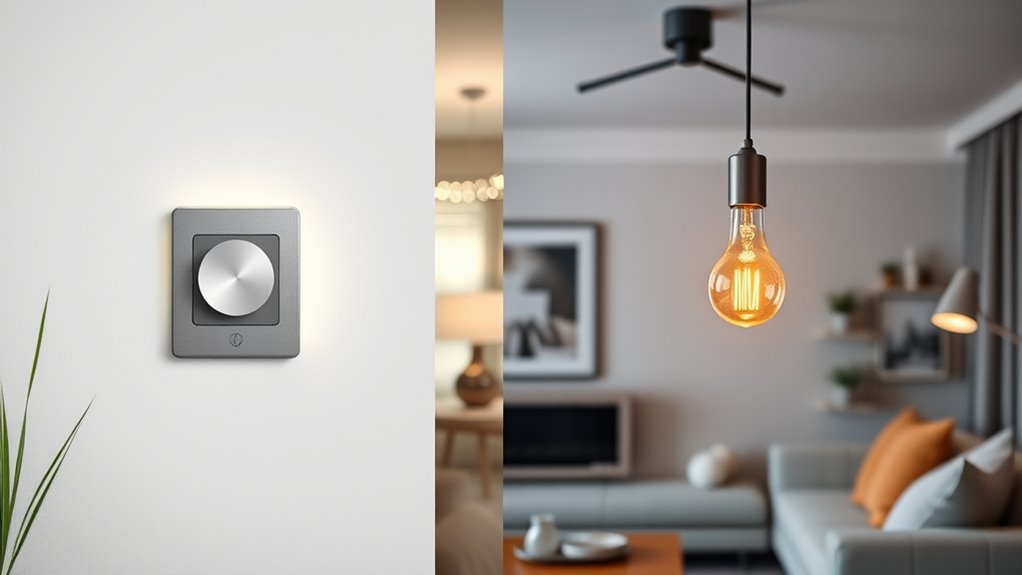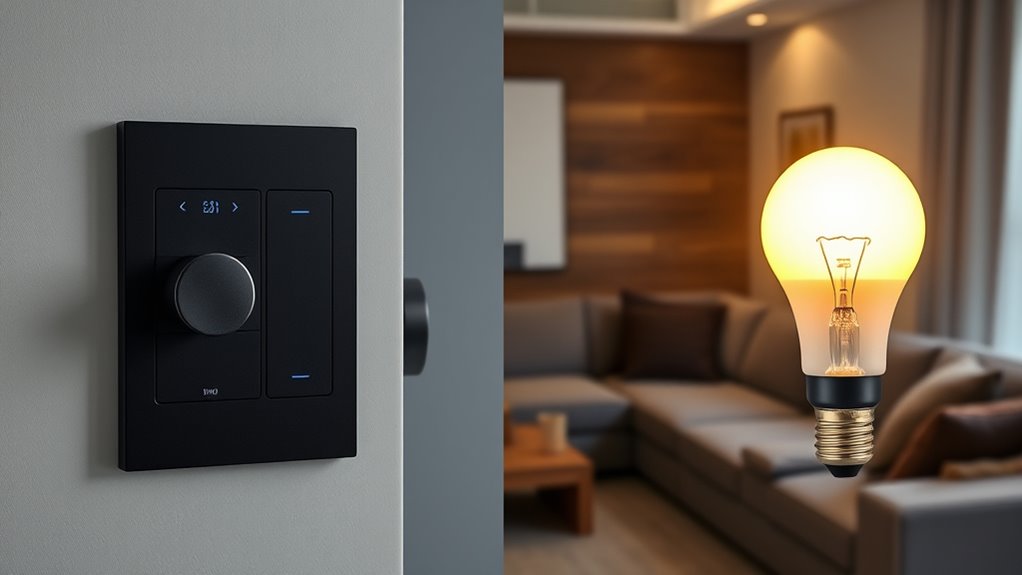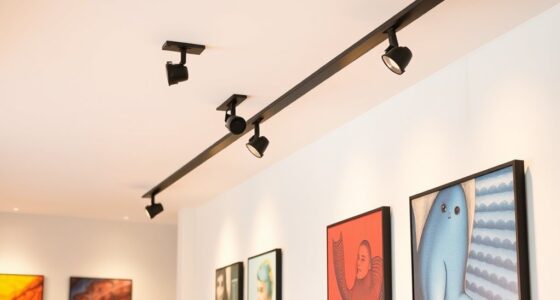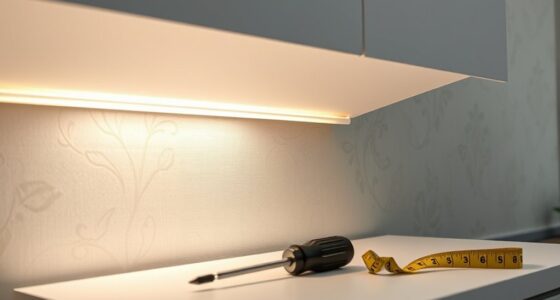Use a smart dimmer when you want adjustable lighting for fixed fixtures, creating ambiance and saving energy with smooth brightness control. Opt for smart bulbs when you need personalized lighting options for individual fixtures, color changes, and custom scenes. Dimmers are ideal for mood or task lighting in living or bedroom areas, while smart bulbs suit decorative or multi-fixture setups. To find the best fit for your needs, learn about their unique features and ideal use cases.
Key Takeaways
- Use smart dimmers for controlling multiple fixtures with adjustable brightness and mood lighting in common areas.
- Choose smart bulbs for individual fixture control, color customization, and decorative lighting in diverse rooms.
- Opt for dimmers when ambiance and energy savings are priorities; select smart bulbs for personalized scenes and color effects.
- Install dimmers in spaces needing consistent, adjustable lighting like living rooms or bedrooms; use smart bulbs where flexibility and aesthetics are key.
- Consider compatibility, installation ease, and control preferences to determine whether a smart dimmer or smart bulb best suits your needs.

When it comes to upgrading your home lighting, choosing between a smart dimmer and a smart bulb can be confusing. Both options offer modern convenience and customization, but each serves different needs based on your lighting design goals and energy efficiency priorities. Understanding when to use a smart dimmer versus a smart bulb helps you make informed decisions that enhance your space and save energy.
Choosing between a smart dimmer and a smart bulb depends on your lighting goals and energy efficiency needs.
A smart dimmer provides a versatile way to control multiple light fixtures from a single switch. If your goal is to create a specific ambiance or improve lighting flexibility, a smart dimmer is ideal. It allows you to adjust brightness levels smoothly, from bright task lighting to soft, relaxing glows, directly affecting your lighting design. This is especially useful in living rooms, dining areas, or bedrooms where mood lighting matters. Additionally, smart dimmers are often compatible with existing fixtures, making installation easier and more seamless. When it comes to energy efficiency, dimmers can reduce energy consumption by lowering light levels instead of turning lights off completely. This not only prolongs bulb life but also cuts down on unnecessary energy use, especially if you prefer softer lighting during certain times of the day. Regular use of dimmers has been shown to improve overall energy savings and extend bulb longevity.
On the other hand, smart bulbs shine in situations where you want quick, flexible control over individual fixtures, especially if you have a variety of light types or fixtures throughout your home. They’re perfect for rooms with multiple lamps, decorative fixtures, or areas where you want to change colors or set schedules. Smart bulbs are easy to install—simply replace your existing bulbs—and can be controlled via smartphone apps, voice commands, or automation systems. They’re a great choice if you want to customize lighting scenes or sync your lighting with other smart home devices. In terms of energy efficiency, many smart bulbs are LED-based and allow you to set schedules or turn lights off remotely, reducing wasted energy. You can also dim them individually, which further conserves power while creating the desired atmosphere.
Ultimately, your choice depends on your lighting design preferences and how much control you want over your lighting environment. If you’re looking for a simple upgrade that offers adjustable lighting and energy savings, a smart dimmer might be the best fit. But if you want more granular control over individual fixtures, personalized lighting scenes, or color-changing options, smart bulbs are the way to go. Both options contribute to energy efficiency and modernize your home, but selecting the right one aligns your lighting setup with your lifestyle and aesthetic goals. Incorporating Glycolic Acid Benefits into your skincare routine can further enhance your skin’s appearance and health, helping you achieve a radiant complexion that complements your well-lit home.
Frequently Asked Questions
Can Smart Bulbs Work With Traditional Dimmer Switches?
Smart bulbs generally don’t work well with traditional dimmer switches because of dimming compatibility issues. If you try to use a smart bulb with a standard switch, you might experience flickering or limited dimming features. For switch integration, it’s best to replace the traditional switch with a smart switch designed for dimming, ensuring smooth operation and full control over your lighting. This way, you avoid compatibility problems altogether.
Are Smart Dimmers Compatible With All Bulb Types?
Imagine a colorful palette of bulbs and dimmer types blending together seamlessly. Smart dimmers aren’t compatible with all bulb types; they work best with dimmable LEDs, incandescent, and halogen bulbs. Check the bulb compatibility prior to installation, as some smart dimmers aren’t suited for certain LEDs or CFLs. Using the right dimmer types ensures smooth operation and avoids flickering or buzzing.
How Do Smart Dimmers Affect Energy Savings?
Smart dimmers improve your energy efficiency by controlling brightness levels, which helps reduce electricity consumption. When you dim the lights, you use less power, leading to cost savings over time. This not only lowers your energy bills but also extends the lifespan of your bulbs. By adjusting brightness based on your needs, you maximize efficiency and save money, making smart dimmers a smart choice for energy-conscious households.
Can I Control Multiple Rooms With One Smart Dimmer?
Sure, you can control multiple rooms with one smart dimmer, but don’t expect a symphony of perfect lighting. Multi-room control is limited by dimmer switch capabilities, which often can’t handle multiple zones or complex setups. Think of it as trying to juggle flaming torches—impressive in theory, but pretty limited in practice. For seamless multi-room control, consider smart bulbs or dedicated systems instead of overloading your dimmer switch limitations.
Do Smart Bulbs Require a Hub or Central Controller?
Smart bulbs typically don’t require a hub or central controller because they use wireless connectivity like Wi-Fi or Bluetooth for lighting automation. You can control them directly with a smartphone app or voice commands. This makes setup easier and more flexible, especially if you want to manage multiple bulbs across your home. Just make certain your Wi-Fi network is strong enough to handle the load for seamless wireless connectivity and smooth lighting automation.
Conclusion
Ultimately, choosing between a smart dimmer and a smart bulb depends on your needs and style. If you want full control over brightness and ambiance, a smart dimmer might be your best bet—think of it as having a mini wizard in your wall. But if you prefer simplicity and color options, a smart bulb is your trusty sidekick. Either way, you’re upgrading your space with a touch of modern magic, making your home feel right out of a sci-fi flick.









